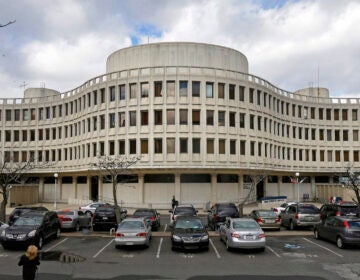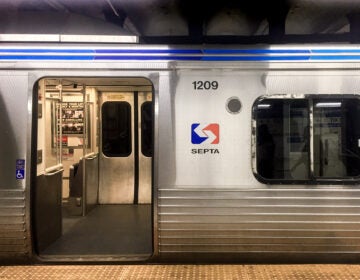Where, oh where, were the falls of East Falls?
Sitting along the banks of the Schuylkill River, the neighborhood of East Falls features a variety of picturesque views, but there are no sounds of rushing water. In fact, you won’t find any indication as to why the area is often referred to as the “Falls of the Schuylkill.”
That’s because East Falls hasn’t had a waterfall in almost 200 years.
The community, located on the east side of the Schuylkill, was fondly named after the original waterfall that resided there until the early 1820s.
By 1822, with the construction of the Fairmount Dam completed several miles down-river, the falls were submerged, leaving only a few protruding rocks visible from land.
Where, and why, did the falls go?
In the online guidebook, “Workshop of the World: A Selective Guide to the Industrial Archeology of Philadelphia,” Jane Mork Gibson explains a deal that was made in 1819 between the city’s Watering Committee, now known as the Philadelphia Water Department (PWD), and two Philadelphia businessmen, Josiah White and Joseph Gillingham.
The book notes that the business duo sold the water power rights at the Falls of the Schuylkill, also known as the “natural fall line of the river,” for $150,000 to the city.
According to the book, White and Gillingham owned a water-powered nail factory on the Schuylkill River and were part of the Schuylkill Navigation Company (SNC), a transportation system that consisted of a series of dams and canals. Under the agreement, the Watering Committee had to build a canal and locks for the SNC.
For the city, the purchase was necessary to build the Fairmount Dam, which, when constructed, would back up the river and cover the falls.
What the ‘Watering Committee’ says today
Although Drew Brown, manager of public education programs for the PWD, shares sentiments about the loss of the falls, he says the Fairmount Dam was necessary to provide a proper supply of drinking water to Philadelphians.
“Knowing the story as I do, I can’t help but wonder that these falls must have been pretty exciting to see, but I think the East Falls community has created its own identity without the waterfall,” said Brown, who cited the Falls Bridge as a noteworthy landmark.
He explained that the technology of water power, made possible by Fairmount Dam, replaced the city’s first water supply technology of steam power.
“The engines pumped water into a reservoir on top of the hill where the art museum sits,” explained Brown. “Because the engines were so expensive to operate, water wheels – much older technology – were adopted. The dam was built to divert the Schuylkill River through the Fairmount Water Works.”
The entire system included pumping stations, reservoirs and a network of water mains.
“Losing the falls was a byproduct of the dam,” said Brown.
He says some private property owners who owned land relatively close to the Fairmount Water Works, several miles from East Falls, were “quite unhappy with the proposal.”
Brown also noted that in the 19th and early 20th centuries, the dam had been breached by floods, which would have allowed water to drain and temporarily restore parts of the falls.
“Each time the dam was breached it has been repaired,” said Brown, who recalled that the last breach was in 1929. “There’s really only one way for the waterfall to be fully restored and that would be to tear down the dam.”
Then and now
While the neighborhood may have a non-existent waterfall as its namesake, Ellen Sheehan, president of the East Falls Historical Society, said residents are well aware of their neighborhood identity.
The 71-year resident is a fourth-generation “Fallser” whose family immigrated from Ireland in the late 1800s and began a family-owned flower shop that operated until the 1950s.
“My father and grandfather also worked as groundskeepers at Laurel Hill Cemetery,” said Sheehan, who worked locally as a teacher at Ravenhill Academy.
“Even they wouldn’t have seen the falls,” said Sheehan. “But I’ve seen old newspaper clippings that referenced the ‘loud roar of the falls.'”
Sheehan says the area was called the Falls of the Schuylkill until around 1910 when “railroads were coming into prominence,” which prompted the naming of the local railroad stop as the “East Falls Train Station.”
She believes the waterfalls would have been in the same spot along the river where the new “East Falls Tapestry” mural art display is under the Twin Bridges.
“The falls would have been right in the area where the Old Falls Tavern used to be, which was built in the 1730s. People used to come up the river on boats and there were steps coming up from the riverbank,” said Sheehan, who also noted that the tavern was demolished in the 1970s.
She says the East Falls Development Corporation (EFDC) has a public improvement plan based on reconnecting East Falls to the River which focuses on the community’s identity as a recreational hub on the banks of the Schuylkill.
“It symbolizes that there was a disconnect at some point,” admitted Sheehan. “Now, we look at the access and proximity we have to the river. If you go to Manayunk, you don’t see the river like you do here.”
With or without the waterfalls, Sheehan says today’s “Fallsers” celebrate the falls through art and recreation and enjoy being a part of a civic-minded “waterfront village.”
WHYY is your source for fact-based, in-depth journalism and information. As a nonprofit organization, we rely on financial support from readers like you. Please give today.










